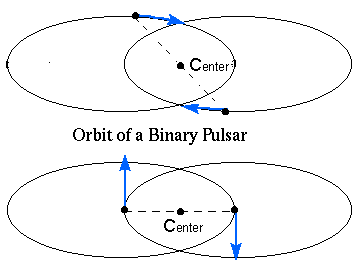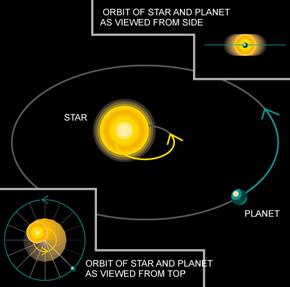Other Special Binaries
 Binary Pulsars
Binary Pulsars The most famous binary radio pulsar is the Hulse-Taylor pulsar, PSR 1913+16, which has another neutron star as its companion.
The two stars are so close that their orbital period is less than eight hours, but no matter streams between them; they interact only by their mutual gravitational attraction. The orbit of the pulsar can be described in great detail because the arrival times of its pulses at the Earth are like the ticks of an accurate clock.
The orbital period is now known to be reducing by 67 nanoseconds (less than one ten-millionth of a second) each orbit. The reducing orbital period represents a loss of energy, which can only be accounted for by gravitational radiation. Although gravitational radiation itself has never been observed directly, the observations of PSR 1913+16 have provided good proof of its existence.

Extrasolar Planets
As a massive planet orbits around a star, they move around their center of mass. For the Sun-Jupiter system, this is a point just outside the Sun's surface. The Star and planet are always on the opposite sides of this center of mass point.
While we are familiar with the thought of a `planet orbiting the Sun', we must realize that in fact, the star also moves. If its a BIG planet, then it causes the star to make a much larger circle for each orbital period. Astronomers look for stars moving in such large circles.
Astronomers from all over the world (U.S., Australia, Switzerland, etc) have discovered planets around >100 stars! A current list, updated every few weeks with new discoveries, can be found HERE.